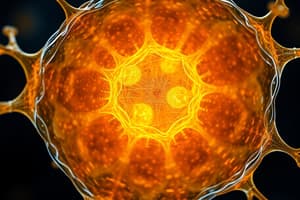Podcast
Questions and Answers
Which of the following is NOT a type of symbiotic relationship?
Which of the following is NOT a type of symbiotic relationship?
- Parasitism
- Mutualism
- Commensalism
- Predation (correct)
Which of the following is a key mechanism driving evolution?
Which of the following is a key mechanism driving evolution?
- Artificial Selection
- Genetic Drift
- Natural Selection (correct)
- Mutation
What is the primary difference between the domains Bacteria and Archaea?
What is the primary difference between the domains Bacteria and Archaea?
- Method of reproduction
- Presence of a nucleus
- Cell structure (correct)
- Habitat
Which of the following describes the process of change in species composition over time?
Which of the following describes the process of change in species composition over time?
Which of the following is NOT a key factor influencing population dynamics?
Which of the following is NOT a key factor influencing population dynamics?
Which of the following organelles is responsible for protein synthesis?
Which of the following organelles is responsible for protein synthesis?
What is the primary function of lysosomes?
What is the primary function of lysosomes?
Which of the following processes is NOT a part of cellular respiration?
Which of the following processes is NOT a part of cellular respiration?
During DNA replication, what is the role of DNA polymerase?
During DNA replication, what is the role of DNA polymerase?
What type of cell division produces gametes with half the number of chromosomes as the parent cell?
What type of cell division produces gametes with half the number of chromosomes as the parent cell?
What is the term for a change in the DNA sequence that can lead to altered gene expression?
What is the term for a change in the DNA sequence that can lead to altered gene expression?
Which level of ecological organization includes all the living organisms within a specific environment?
Which level of ecological organization includes all the living organisms within a specific environment?
What is the process by which energy from sunlight is converted into chemical energy in the form of glucose?
What is the process by which energy from sunlight is converted into chemical energy in the form of glucose?
Flashcards
Interactions between species
Interactions between species
Includes competition, predation, and symbiosis types like mutualism, commensalism, and parasitism.
Natural selection
Natural selection
A process where individuals with advantageous traits survive and reproduce more successfully.
Speciation
Speciation
The formation of new and distinct species during the course of evolution.
Classification systems
Classification systems
Signup and view all the flashcards
Fossil record
Fossil record
Signup and view all the flashcards
Cell
Cell
Signup and view all the flashcards
Prokaryotic Cells
Prokaryotic Cells
Signup and view all the flashcards
Eukaryotic Cells
Eukaryotic Cells
Signup and view all the flashcards
Mitochondria
Mitochondria
Signup and view all the flashcards
Photosynthesis
Photosynthesis
Signup and view all the flashcards
DNA Replication
DNA Replication
Signup and view all the flashcards
Mitosis
Mitosis
Signup and view all the flashcards
Ecology
Ecology
Signup and view all the flashcards
Study Notes
Cell Structure and Function
- Cells are the basic units of life, exhibiting a wide range of shapes and sizes.
- They are complex systems containing various organelles that perform specific functions.
- Prokaryotic cells (bacteria, archaea) lack a nucleus and membrane-bound organelles, while eukaryotic cells (plants, animals, fungi, protists) possess these features.
- Common eukaryotic organelles include the nucleus (containing DNA), mitochondria (energy production), ribosomes (protein synthesis), endoplasmic reticulum (protein and lipid synthesis), Golgi apparatus (modification and packaging of proteins), and lysosomes (waste disposal).
- Plant cells are distinguished by cell walls, chloroplasts (photosynthesis), and large central vacuoles.
- Animal cells, on the other hand, are diverse and lack cell walls and chloroplasts.
Cellular Processes
- Metabolism encompasses all chemical reactions within a cell.
- Catabolism breaks down molecules to release energy, while anabolism builds larger molecules from smaller ones.
- Cellular respiration is the process of extracting energy from glucose, producing ATP.
- Photosynthesis transforms light energy into chemical energy in the form of glucose.
- DNA replication ensures accurate duplication of genetic material before cell division.
- Protein synthesis involves transcription (DNA to RNA) and translation (RNA to protein).
- Mitosis and meiosis are the processes of cell division.
- Mitosis produces identical daughter cells, essential for growth and repair.
- Meiosis produces gametes (sperm and egg) with half the chromosome number, crucial for sexual reproduction.
Genetics
- Genes are segments of DNA that code for specific traits.
- DNA carries the genetic information needed for cell function and development.
- The structure of DNA is a double helix with nucleotides forming the building blocks.
- DNA replication ensures the accurate copying of genetic material.
- Genes can be expressed as proteins, the workhorses of the cell, via transcription and translation processes.
- Mutations in DNA can lead to altered gene expression and potentially harmful effects.
- Inheritance patterns can follow Mendelian or non-Mendelian patterns, depending on gene interactions.
Ecology
- Ecology is the study of organisms and their interactions with each other and their environment.
- Organisms are classified into different levels within the ecosystems: individuals, populations, communities, and ecosystems.
- Interactions between species include competition, predation, and symbiosis (mutualism, commensalism, parasitism).
- Energy flows through ecosystems via food chains and food webs.
- Biotic factors (living organisms) and abiotic factors (nonliving components) influence populations and community dynamics.
- Succession describes the changes in species composition over time.
- Several biomes exist based on climate and vegetation.
Evolution
- Evolution is the change in inherited characteristics of a biological population over successive generations.
- Natural selection is a key mechanism driving evolution, where individuals with advantageous traits are more likely to survive and reproduce.
- Genetic variation within populations is essential for evolution to occur.
- Speciation is the formation of new and distinct species in the course of evolution.
- The fossil record provides evidence of past life forms and evolutionary changes.
Diversity of Life
- Life on Earth is incredibly diverse, with millions of species.
- Classification systems (e.g. Linnaean system) organize species into hierarchical groups based on shared characteristics.
- Living organisms can be grouped into three domains: Bacteria, Archaea, and Eukarya.
- Each domain is further divided into kingdoms (e.g., Animalia, Plantae, Fungi).
- Adaptations are specialized characteristics that aid survival in different environments.
Studying That Suits You
Use AI to generate personalized quizzes and flashcards to suit your learning preferences.




